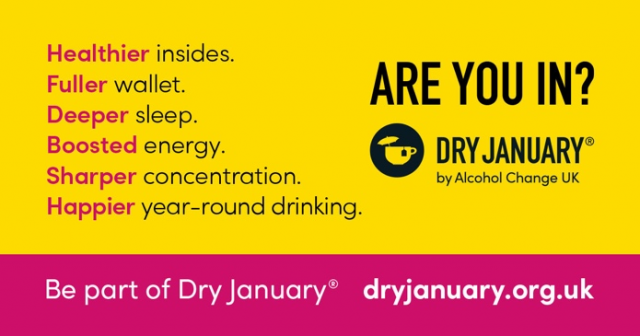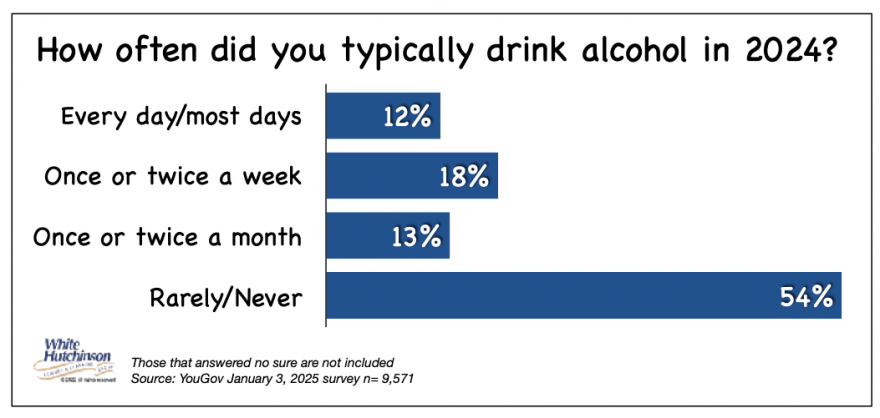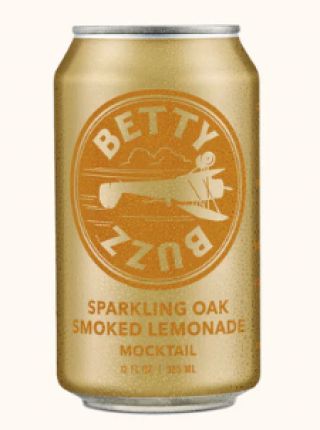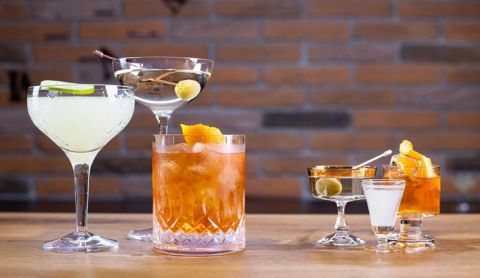
Vol. XXV, No. 2, February 2025
Sobering news for venues that serve alcohol
For the past several e-newsletters, we discussed the sober-curious trend and the continual decline in alcohol consumption, especially among younger adults. If you missed them, you can check them out here, here, and here. For those of us who grew up in a time when alcohol consumption was widely accepted- if not encouraged- it can't be overstated how much this perception is changing and the potential it has to affect the food and beverage industry. If your business earns revenue from alcohol, it is time to take the growing sober movement seriously.

After the excess and indulgence of the holidays ended, the new year began with resolutions for healthier living. One popular resolution is Dry January, a challenge to abstain from alcohol for the month of January, first launched in the UK in 2013 as part of a health campaign. Since then, the challenge has grown in popularity worldwide. According to a CivicScience poll, a quarter of adults (25%) participated in Dry January in 2024. This represents a 30% increase from the 16% who participated in 2023.
Of course, January is only one month with many participants using it as a reset from overindulgence in December. However, data continues to emerge that supports the broader, long-term decline in alcohol consumption well beyond January.
A new YouGov poll surveying almost 10,000 U.S. adults on their frequency of alcohol consumption in 2024 showed that the majority (54%) of adults rarely or never drank in 2024, and the number who drank every day or most days was only 12%.

Another recent poll by Gallup found that in 2024, 45% of adults believed drinking in moderation (1-2 drinks/day) is actively bad for your health, a two-thirds (66%) increase from 2001. When looking at adults ages 18-35, this number grows to 65%, more than doubling from the 30% who believed this in 2001.
This shift in perception of alcohol consumption, from a fun, cool activity to one that is perceived as unhealthy and irresponsible, parallels the changing views on smoking over the last 20 years. An advisory issued by Surgeon General Dr. Vivek Murthy earlier this month underscores this similarity by linking alcohol to an increase in several types of cancer and identifying alcohol consumption as the third leading preventable cause of cancer after tobacco and obesity. While there are currently no cancer warnings on alcoholic products, that may soon change as Murthy recommends steps to increase awareness of this link, including updating warning labels on alcoholic products, reassessing guideline limits, and expanding educational efforts.
For LBEs who serve alcohol, this news is concerning and with good reason, as alcohol has traditionally been a key revenue and profit driver. Although the interest in alcohol is waning, the need to celebrate and socialize with quality food and beverages remains universal, and non-alcoholic beers, wines, and especially mocktails are happy to fill that niche. According to Chicago-based Circana, case sales of non-alcoholic beer were up 20% in 2024, while the Independent National Food Retailers Association reported a 40% increase in mocktails and other non-alcoholic spirits sales.

Sparkling Oak Smoked Lemonade Mocktail from Blake Lively's brand Betty Buzz.
If you decide to delve into the world of non-alcoholic beverages (and we highly suggest you do!), you will find yourself in good company. Celebrities are increasingly endorsing and launching their own non-alcoholic spirits, beer, and wine brands. Singer Katy Perry launched De Soi , her brand of alcohol-free aperitifs, and actors Danny Trejo and Tom Holland have both launched alcohol-free brands, Trejo's Spirits and Bero Brewing Company. Other celebs have added NA options to their alcoholic repertoire, such as Blake Lively and Kylie Minogue, and still, others have crafted "wellness beverages," high-quality soft drinks with complex flavors and ingredients chosen for their health and wellness benefits, such as Gillian Anderson's G Spot. The endorsements of celebrities have helped market alcohol-free options as aspirational and wellness-focused lifestyle products.
To succeed in the world of non-alcoholic beverages and to attain the price point that a quality drink commands, it is essential to give NA beverages the same attention that you would give an alcoholic beverage. Provide a selection of NA beers in different styles such as stouts, pilsners, and IPAs, emphasize local brewers, and rotate in seasonal beers. For mocktails, introduce complex flavors with botanicals, herbs, and syrups to provide your guests with the same cocktail experience that they get from an alcoholic cocktail. If you want to stay current on all things non-alcoholic, Zero Proof Nation is an excellent resource, providing information on the latest NA brands and trends. You can sign up for their newsletter here.
For customers who aren't total tee totalers and still want a little alcohol, but in moderation, several options are available to accommodate them beyond just serving them fewer drinks, such as lower alcohol cocktails such as spritzers. Another option is session beers, which are lower-alcohol craft beers, usually with around 4% alcohol. Since craft beers typically have a much higher alcohol content than domestic beers, session beers allow craft breweries to provide a beer with a more reasonable alcohol level while still giving the drinker the flavor and variety found with craft beers. The name session comes from the idea that they can be drunk over a session of time without making the drinker overly intoxicated.

Traditional cocktails with their mini versions.
The most interesting new trend in low-alcohol beverages that we have come across is mini-cocktails. Mini (micro or tiny) cocktails are typically 1-2 ounces served in adorably small glassware. Classic cocktails such as the gimlet, old-fashioned, and martini are popping up in miniature form at bars from New York to Atlanta. The miniature daquiri is so popular it has its own name, the snaquiri. Although the trend seems new, cocktails used to be much smaller in the '20s and '30s and only grew in size in the 1940s. The mini cocktails also evoke the tradition of the "bartender's handshake," a small drink bartenders would make for other bartenders visiting their bar. Think of it like a liquid amuse-bouche. The beauty of mini cocktails is that they can be served in small portions functioning both as a light drink for those choosing to imbibe less or allowing guests to indulge in several different drinks without drinking excessively.
The bottom line is that multiple factors have come together to make alcoholic drinking, especially heavy drinking, less popular. To retain the revenue that alcoholic beverages have traditionally brought in, augmenting your beverage menu with low and non-alcoholic alternatives will be necessary. So, if you are looking to make a resolution for 2025 that will help in future-proofing your business, resolve to prioritize high-quality low and non-alcoholic beverages at your venue.
Subscribe to monthly Leisure eNewsletter


